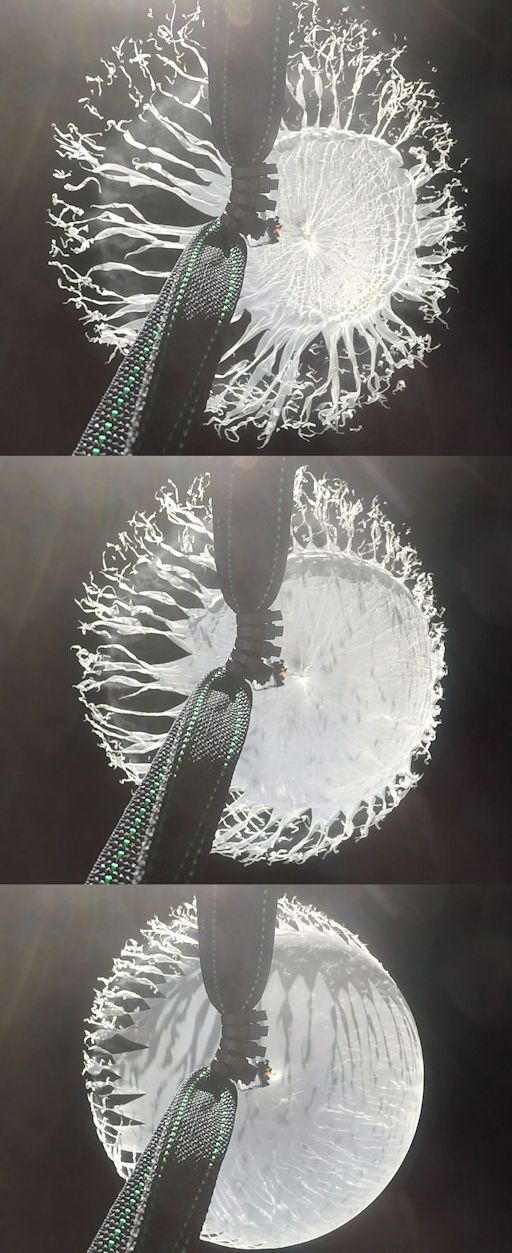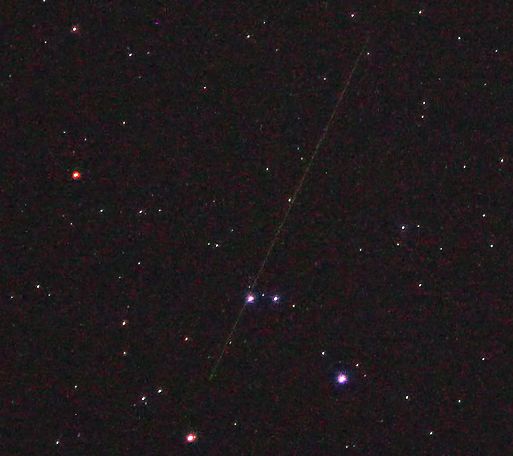Marianne's Heaven On Earth Aurora Chaser Tours Chasethelighttours.co.uk invites you to join them in their quest to find and photograph the Aurora Borealis. Experience the winter wonderland in the Tromsø Area. | | | TOTAL ECLIPSE OF THE SUN: In less than a week, there's going to be a total eclipse of the sun. On March 9th, the new Moon will pass directly in front of the sun, bringing night to day and revealing the sun's ghostly corona. The path of totality cuts across Indonesia and the Pacific Ocean: animated map. Spaceweather.com is sending a team of students to observe the eclipse and test cameras for the Solar Eclipse Balloon Network. Stay tuned for updates. SOLAR WIND SPARKS AURORAS: A solar wind stream is gently buffeting Earth's magnetic field, and this is sparking auroras around the Arctic Circle. Truls Tiller saw this display last night in Grøtfjorden, Norway: 
"We took some guests outside to hunt for the aurora," says Tiller. "I had a good feeling about the night--and those feelings were justified. A nice display and some very happy guests made the night complete. " This is not a strong solar wind stream. Nevertheless, it is doing a good job lighting up Arctic skies. NOAA forecasters say the influence of the stream could last for two more days with a 20% chance of G1-class geomagnetic storms. Aurora alerts: text or voice Realtime Aurora Photo Gallery PHYSICS OF AN EXPLODING SPACE WEATHER BALLOON: On Feb. 27th, the students of Earth to Sky Calculus launched a space weather balloon to measure increasing levels of cosmic rays. At the apex of the flight, the balloon exploded as planned and the radiation sensors parachuted back to Earth. A high-speed camera on top of the payload captured some extraordinary images of the pop: 
These images illustrate new findings about the physics of exploding balloons. In Oct. 2015, researchers Sébastien Moulinet and Mokhtar Adda-Bedia of the Ecole Normale Supérieure published a Physical Review Letter entitled "Popping Balloons: A Case Study of Dynamical Fragmentation." In it, they reported the results of a series of fun yet informative laboratory experiments in which one balloon after another was popped and analyzed. Basically, there are two ways a balloon can pop: along a single team (the "opening regime") or along many tears (the "fragmentation regime"). This video shows the two regimes in action. Which way the balloon decided to pop depends on the stress in the rubber membrane. When the stress is low, it can be relieved with a single tear, but when the stress is high, many tears are required to do the job. Clearly, space weather balloons explode in the fragmentation regime. This is hardly a surprise. When space weather balloons are launched, they measure no more than 6 to 8 feet in diameter. By the time they reach the stratosphere, they have stretched into a sphere as wide as a house. That's a lot of tension to release! More information about this research is available from the American Physical Society. NORTH KOREAN SATELLITE: When North Korea launched a rocket on Feb. 7th, purportedly carrying an Earth observing satellite to orbit, observers were skeptical. Some dismissed the launch as a ruse for testing an ICBM. It turns out, however, there really is a satellite. On Feb. 28th, veteran satellite tracker Marco Langbroek saw it flying over Leiden, the Netherlands: 
"North Korea's new satellite Kwangmyŏngsŏng-4 (KMS-4) is starting to make visible evening passes over Europe," says Langbroek. Shortly after the launch, some experts wondered if the satellite might have failed to deploy properly and started tumbling around Earth. However, that's not what Langbroek saw: "As far as I can tell over the short imaging arc (~6 seconds) there was no brightness variation. So the satellite is stable, or if it is tumbling it must be a very slow tumble," he says. Readers who wish to see Kwangmyŏngsŏng-4 for themselves may find tracking data here. Realtime Spaceweather Photo Gallery
Realtime Comet Photo Gallery Every night, a network of NASA all-sky cameras scans the skies above the United States for meteoritic fireballs. Automated software maintained by NASA's Meteoroid Environment Office calculates their orbits, velocity, penetration depth in Earth's atmosphere and many other characteristics. Daily results are presented here on Spaceweather.com. On Mar. 2, 2016, the network reported 8 fireballs.
(8 sporadics)  In this diagram of the inner solar system, all of the fireball orbits intersect at a single point--Earth. The orbits are color-coded by velocity, from slow (red) to fast (blue). [Larger image] [movies] Potentially Hazardous Asteroids ( PHAs) are space rocks larger than approximately 100m that can come closer to Earth than 0.05 AU. None of the known PHAs is on a collision course with our planet, although astronomers are finding new ones all the time. On March 2, 2016 there were potentially hazardous asteroids.  | Notes: LD means "Lunar Distance." 1 LD = 384,401 km, the distance between Earth and the Moon. 1 LD also equals 0.00256 AU. MAG is the visual magnitude of the asteroid on the date of closest approach. | | Cosmic Rays in the Atmosphere | | Situation Report -- Oct. 30, 2015 | Stratospheric Radiation (+37o N) | | Cosmic ray levels are elevated (+6.1% above the Space Age median). The trend is flat. Cosmic ray levels have increased +0% in the past month. | | Sept. 06: 4.14 uSv/hr (414 uRad/hr) | | Sept. 12: 4.09 uSv/hr (409 uRad/hr) | | Sept. 23: 4.12 uSv/hr (412 uRad/hr) | | Sept. 25: 4.16 uSv/hr (416 uRad/hr) | | Sept. 27: 4.13 uSv/hr (413 uRad/hr) | | Oct. 11: 4.02 uSv/hr (402 uRad/hr) | | Oct. 22: 4.11 uSv/hr (411 uRad/hr) | These measurements are based on regular space weather balloon flights: learn more. Approximately once a week, Spaceweather.com and the students of Earth to Sky Calculus fly "space weather balloons" to the stratosphere over California. These balloons are equipped with radiation sensors that detect cosmic rays, a surprisingly "down to Earth" form of space weather. Cosmic rays can seed clouds, trigger lightning, and penetrate commercial airplanes. Our measurements show that someone flying back and forth across the continental USA, just once, can absorb as much ionizing radiation as 2 to 5 dental X-rays. For example, here is the data from a flight on Oct. 22, 2015: 
Radiation levels peak at the entrance to the stratosphere in a broad region called the "Pfotzer Maximum." This peak is named after physicist George Pfotzer who discovered it using balloons and Geiger tubes in the 1930s. Radiation levels there are more than 80x sea level. Note that the bottom of the Pfotzer Maximim is near 55,000 ft. This means that some high-flying aircraft are not far from the zone of maximum radiation. Indeed, according to the Oct 22th measurements, a plane flying at 45,000 feet is exposed to 2.79 uSv/hr. At that rate, a passenger would absorb about one dental X-ray's worth of radiation in about 5 hours. The radiation sensors onboard our helium balloons detect X-rays and gamma-rays in the energy range 10 keV to 20 MeV. These energies span the range of medical X-ray machines and airport security scanners. | | The official U.S. government space weather bureau | | | The first place to look for information about sundogs, pillars, rainbows and related phenomena. | | | Researchers call it a "Hubble for the sun." SDO is the most advanced solar observatory ever. | | | 3D views of the sun from NASA's Solar and Terrestrial Relations Observatory | | | Realtime and archival images of the Sun from SOHO. | | | from the NOAA Space Environment Center | | | the underlying science of space weather | | 
